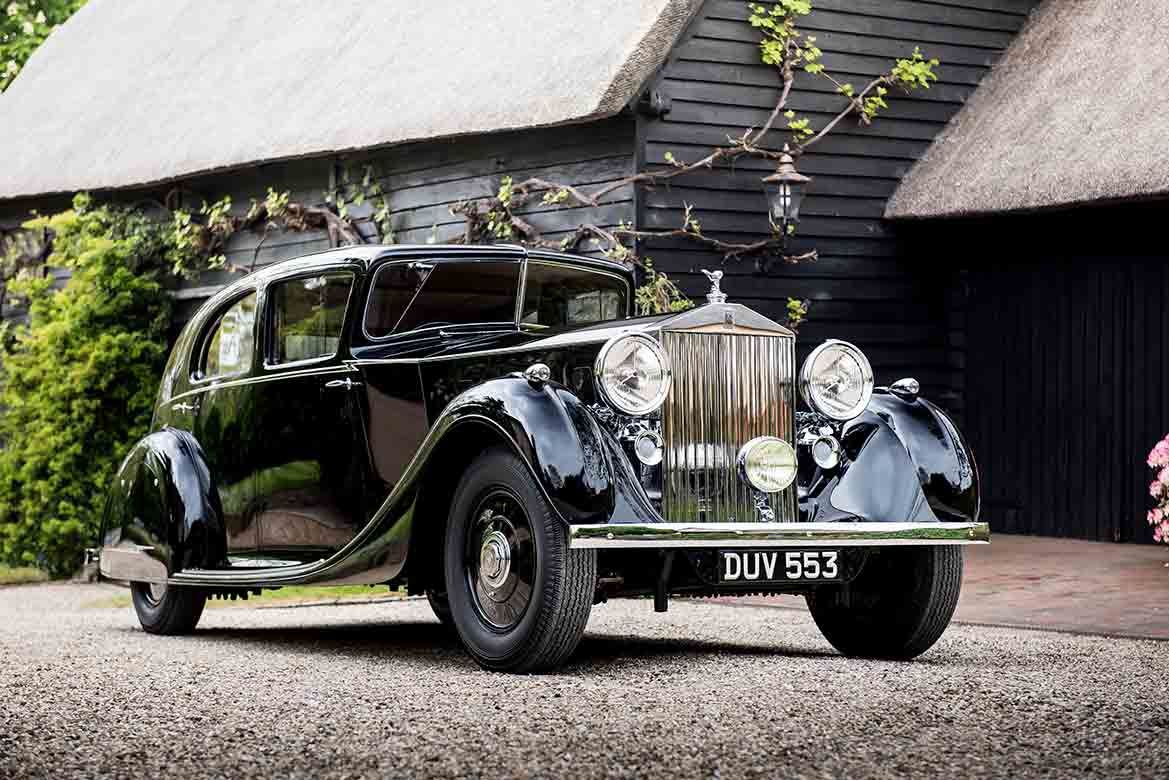2024 年 8 月 1 日
“品牌车型”系列的第四部作品是劳斯莱斯幻影 III。幻影 III 于 1936 年推出,是首款采用 V12 发动机的车型,为包括现代在内的每款劳斯莱斯车型树立了模板。这也是亨利·莱斯爵士 1933 年去世前的最后一个主要设计。
- 1936 年推出的劳斯莱斯幻影 III 简史
- 第一辆搭载 V12 发动机的劳斯莱斯汽车
- 亨利·莱斯爵士 1933 年去世前的最后一项重要设计
- 该品牌首款全电动车型 Spectre 的命名灵感源自 1934 年至 1937 年间生产的十辆实验性幻影 III
- 这是品牌历史上具有里程碑意义的车型系列的第四部
- 为期一年的回顾展是为了纪念亨利·莱斯和查尔斯·斯图尔特·罗尔斯于 1904 年首次会面的 120 周年
“幻影 III 于 1936 年推出,在劳斯莱斯汽车殿堂中占有特殊地位。它是第一款采用 V12 发动机的车型,为每一款劳斯莱斯汽车树立了模板,包括现代车型,同时还采用了悬挂和底盘技术,确保了该品牌在无与伦比的舒适性和出色性能方面经久不衰的声誉。这款汽车也有某种辛酸之处。尽管技术进步和潜力巨大,但生产于 1939 年停止,从未恢复,留下了一个问题,如果恢复生产会怎样。这也是亨利·莱斯爵士的最后一个主要设计,他于 1933 年去世,这意味着他从未亲眼看到它的完成。但是,作为一位有远见的人,他建立了基本的技术和设计原则,这些原则至今仍然适用。”
安德鲁·鲍尔 (Andrew Ball),劳斯莱斯汽车公司企业关系和历史传承主管
早在 1930 年,亨利·莱斯爵士就意识到他的大马力直列六缸劳斯莱斯发动机已达到技术极限。 简单来说,他无法从这些发动机中获得更多的功率或扭矩。 他意识到劳斯莱斯可能会输给其美国竞争对手,因为美国竞争对手当时正在忙于生产搭载更强大发动机的豪华轿车,包括 V8、V12 甚至 V16 配置。
莱斯在设计 V12 航空发动机方面拥有丰富的经验,而劳斯莱斯在制造此种发动机方面也同样熟练。 因此,对莱斯来说,为 1929 年问世的幻影 II 的继任者打造 V12 发动机是合乎逻辑且自然而然的进展。 莱斯
的新发动机代表了重大的技术进步。新款 V12 发动机比 Phantom II 的直列六缸发动机短,排量为 7.3 升,而前代车型排量为 7.6 升。这些更紧凑的尺寸允许使用更短的发动机罩和更大的乘客舱,为车身制造商提供了比早期劳斯莱斯滚动底盘更大的空间。然而,最重要的是,新发动机提供了劳斯莱斯所寻求的更大功率。在最初的版本中,它产生 165 马力,而 Phantom II 为 120 马力,在后来的汽车中上升到 180 马力。
底盘的设计也实现了重大飞跃。作为该品牌的另一项首创,罗伊斯为幻影 III 配备了独立前悬架,这一创新大大提高了乘坐舒适度和转向控制。他的设计团队还融入了大量车主和乘客可能永远不会注意到的小型工程改进,但大大降低了由不良路面引起的噪音、振动和不平顺性的传输。总而言之,这些发展使幻影 III 成为 20 世纪 30 年代最安静、最平稳的汽车之一。当安装罗伊斯偏爱的轻型车身时,它能够达到每小时 100 英里。
罗伊斯见证了发动机的实验版本完成,但他于 1933 年 4 月去世,距第一批测试车准备就绪还有一年。1934 年至 1937 年间,共制造了 10 辆这种实验性的幻影 III 汽车,代号为Spectre,这个传奇的名字至今仍存在于该品牌的首款全电动车型中。
第一辆幻影 III 量产车底盘于 1936 年 8 月交付,其车身为 HJ Mulliner 打造的带分隔的轿车式车身。在劳斯莱斯于 1939 年停止汽车生产之前,共生产了 710 辆幻影 III;最后一辆幻影 III 于 1940 年 6 月被购买。
劳斯莱斯的董事们知道,一旦和平恢复,他们将在一个截然不同的世界里运营,而幻影 III 这样的汽车将不再有立足之地。与 1918 年相比,劳斯莱斯品牌可能更需要将精力集中在更符合时代的车型上,同时继续建立劳斯莱斯所期望的品质和精致标准。因此,尽管幻影 III 技术精湛、性能卓越、具有巨大的进一步发展潜力,但它短暂而变革的一生还是结束了。然而,它的影响在每辆劳斯莱斯汽车中都能感受到,包括如今仍在古德伍德制造的 V12 动力车型。幻影 III 的设计和工程卓越性以及其创造者的远见卓识都是永恒的见证。
MODELS OF THE MARQUE: THE 1930s THE ROLLS-ROYCE PHANTOM III
01.08.2024
The fourth in the ‘Models of the Marque’ series showcases the Rolls-Royce Phantom III. Launched in 1936, it was the first model to be powered by a V12 engine, setting the template for every Rolls-Royce up to and including the modern era. It was also Sir Henry Royce’s last major design before his passing in 1933.
- A brief history of the Rolls-Royce Phantom III launched in 1936
- The first Rolls-Royce motor car powered by a V12 engine
- Sir Henry Royce’s last major design before his passing in 1933
- Naming of the marque’s first all-electric model, Spectre, was inspired by ten experimental Phantom IIIs built from 1934 to 1937
- Fourth in a series celebrating landmark models from the marque’s history
- Year-long retrospective marks the 120th anniversary of the first meeting between Henry Royce and The Hon. Charles Stewart Rolls in 1904
“Launched in 1936, Phantom III has a special place in the pantheon of great Rolls-Royce motor cars. It was the first to be powered by a V12 engine, setting the template for every Rolls-Royce up to and including the modern era, while also incorporating suspension and chassis technology that secured the marque’s enduring reputation for both peerless comfort and outstanding performance. There is a certain poignancy to this motor car, too. Production ceased in 1939 and, despite its technical advances and immense potential, never resumed, leaving a question of what might have been. It was also Sir Henry Royce’s last major design, which his death in 1933 meant he never saw completed. But, visionary that he was, he had established fundamental technical and design tenets that still hold true today.”
Andrew Ball, Head of Corporate Relations & Heritage, Rolls-Royce Motor Cars
As early as 1930, Sir Henry Royce realised that his large-horsepower, in-line six-cylinder Rolls-Royce engines were reaching their technical limits. In simple terms, there wasn’t much more power or torque he could feasibly extract from them. He realised that Rolls-Royce risked losing ground to its American rivals, who were already busily producing luxury cars with much more powerful engines in V8, V12, and even V16 configurations.
Royce had a wealth of experience in designing V12 aero engines, and Rolls-Royce was equally adept at making them. It was therefore a logical and natural progression for Royce to create a V12 engine for the successor to Phantom II, which had appeared in 1929.
Royce’s new engine represented significant technical progress. The new V12 was shorter than Phantom II’s in-line six-cylinder unit, with a capacity of 7.3 litres compared to its predecessor’s 7.6 litres. These more compact dimensions allowed a shorter bonnet and larger passenger compartment, giving coachbuilders more scope than earlier Rolls-Royce rolling chassis. Most importantly, however, the new engine delivered the increased power Royce was seeking. In its initial form, it produced 165 H.P., compared to the 120 of Phantom II, rising to 180 in later motor cars.
The chassis, too, was a major leap forward in design. In another first for the marque, Royce equipped Phantom III with independent front suspension, an innovation that considerably increased both ride comfort and steering control. Characteristically, his design team also incorporated a great number of smaller engineering advances that owners and passengers would probably never notice but greatly reduced the transmission of noise, vibration and harshness caused by poor road surfaces. Taken together, these developments made the Phantom III one of the quietest and smoothest-riding cars of the 1930s. When fitted with Royce’s preferred lightweight coachwork, it was capable of reaching 100 miles per hour.
Royce saw experimental versions of the engine completed, but his death in April 1933 came a year before the first test cars were ready. Ten of these experimental Phantom III motor cars were built between 1934 and 1937 under the codename Spectre, a storied name that lives on today in the marque’s first all-electric model.
The first production Phantom III chassis, sporting a saloon-with-division body built by H. J. Mulliner, was delivered in August 1936. In all, 710 examples were produced, before Rolls-Royce ceased its motor car production in 1939; the last Phantom III was purchased in June 1940.
The directors of Rolls-Royce knew that, once peace returned, they would be operating in a very different world – and that there would be no place in it for a motor car like Phantom III. Perhaps even more so than in 1918, the marque would have to focus its energies on models that were more in keeping with the time, while continuing to build upon the standards of quality and refinement expected of a Rolls-Royce. So, despite its technical brilliance, superlative performance and immense potential for further development, its brief but transformative life was over. Yet its influence would be felt in every Rolls-Royce motor car right up to and including the V12-powered models still being built at Goodwood today. An enduring testament to both the excellence of Phantom III’s design and engineering, and the visionary talents of its creator.

